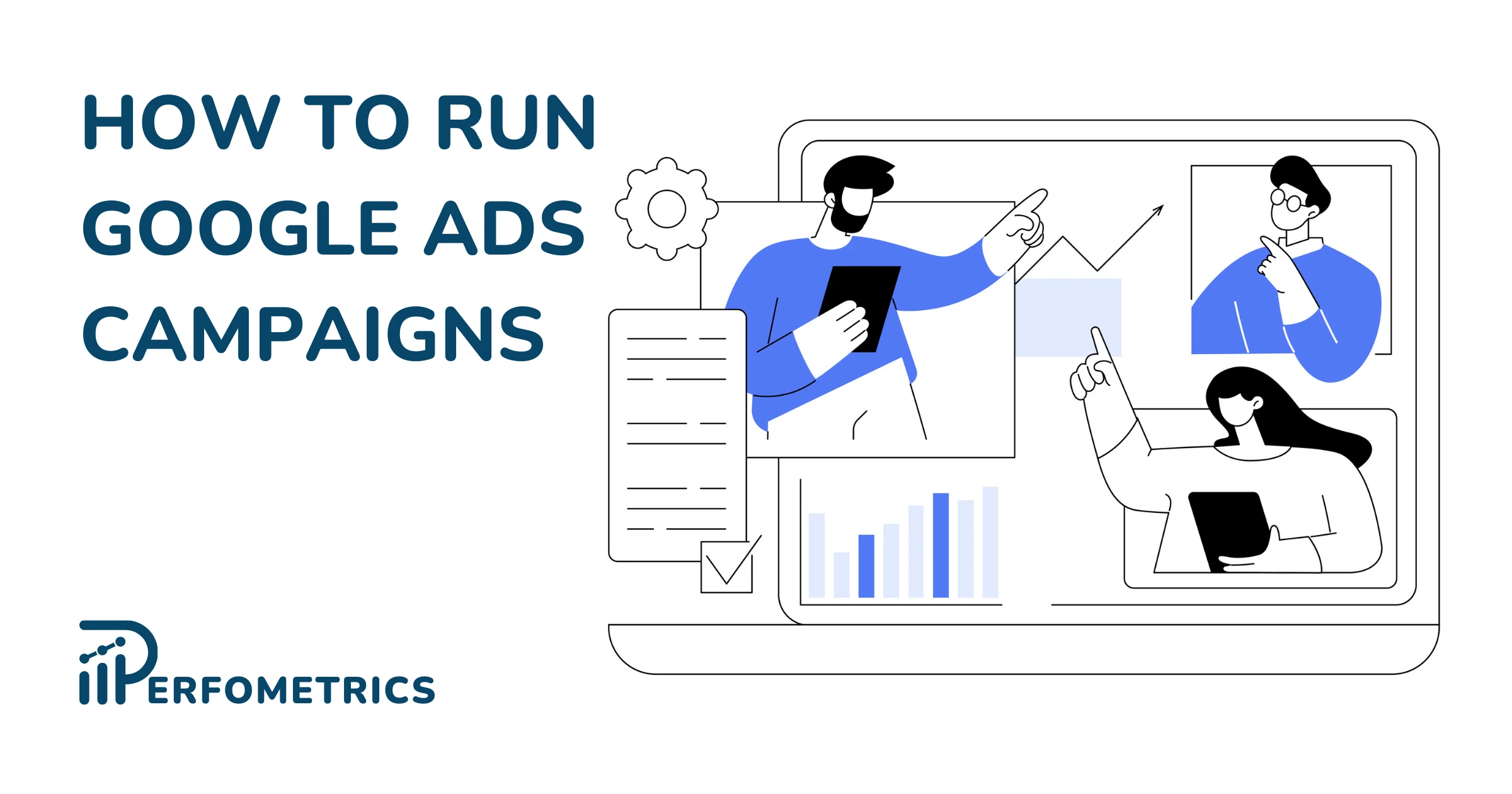How to Run a Google Ads Campaign [Step-by-Step Guide]

Before diving into the intricacies of running a Google Ads campaign, it’s crucial to establish a solid foundation – creating a well-structured, effective Google Ads campaign from the start. This involves carefully considering factors like campaign type, ad groups, keywords, target audience, bidding strategies, and landing pages. Each element plays a pivotal role in determining the overall success of your campaign.
By laying this solid foundation, you pave the way for consistent optimization and performance improvement throughout the campaign lifecycle. Follow our detailed step-by-step guide to help you create a successful Google Ads campaign.
Now that your Google Ads campaign is up and running, it’s time to focus on refining and managing your campaign for continuous improvement and success. This involves analyzing your campaign performance, testing different ad variations, optimizing your bidding strategies, and more.
How to Run a Successful Google Ads Campaign?
Multiple elements go into running a successful Google Ads campaign, such as tracking demand, having a clear goal, writing ads with the customer in mind, optimizing your keywords and audiences, creating a strong selling proposition, setting up conversion tracking, using Smart Bidding strategies and regularly analyzing campaign performance.
1. Analyze Campaign Performance
Effective campaign management hinges on a deep understanding of campaign performance. By analyzing key metrics, you can identify areas of strength, weaknesses, and opportunities for improvement. This data-driven approach allows you to optimize your campaigns and maximize their effectiveness, driving better results and achieving your marketing goals.
Why is Campaign Performance Analysis Essential?
- Measure Success: Data provides objective metrics to evaluate the effectiveness of your campaigns. You can track key performance indicators (KPIs) such as spending, impressions, clicks, conversions, and cost-per-click (CPC) to assess progress toward your goals.
- Identify Strengths and Weaknesses: By analyzing performance data, you can identify which elements of your campaigns are performing well and which need improvement. This allows you to refine your strategies, targeting, and bidding to enhance overall effectiveness.
- Optimize for Efficiency: Data-driven optimization helps you allocate your marketing budget efficiently. You can maximize your return on investment (ROI) and drive conversions without overspending by targeting the right keywords, audiences, and placements.
How to Analyze Campaign Performance
- Establish Key Performance Indicators (KPIs): Define the metrics that matter most to your business, such as website visits, leads, and sales, as well as CTR, CPC, and CVR.
- Break Down the Data: Analyze performance at granular levels, keywords, and audiences to identify trends and patterns.
- Compare Performance over Time: Track performance over weeks, months, and quarters to identify seasonal trends or shifts in user behavior.
- Identify Outliers and Investigate Further: Look for anomalies or sudden changes in performance, which may indicate issues that require attention.
- Combine Data with Other Analytics Sources: Integrate data from Google Analytics and other sources to get a holistic view of your marketing efforts.
By regularly reviewing these metrics, such as Google Ads campaign budgets, you can gain a better understanding of how your campaign is performing and identify opportunities for improvement.
2. Optimize Keywords
Effective keyword optimization involves a strategic approach that encompasses keyword research, keyword match types, negative keywords, and ad group structure.
By conducting thorough keyword research, selecting the appropriate keyword match types, eliminating irrelevant keywords, and organizing keywords into relevant ad groups, you can ensure your ads are tailored to specific search intent, leading to increased click-through rates, improved quality scores, and reduced wasted ad spend.
Keyword optimization is an important element in running a successful Google Ads campaign for several reasons:
- Targeted Traffic: By targeting relevant keywords, you attract users who are actively searching for products or services like yours. This ensures that your ads are seen by people who are genuinely interested in what you offer.
- Improved Click-Through Rates (CTRs): Targeted keywords resonate with searchers, making them more likely to click on your ads. A higher CTR leads to more clicks, driving more traffic to your website.
- Lower Cost-per-Click (CPCs): By selecting relevant keywords, you avoid bidding on irrelevant searches, which can drive up CPCs and reduce your ROI. Targeted keyword selection ensures that you’re paying for clicks from genuine potential customers.
- Enhanced Conversion Rates: When users click on ads for relevant keywords, they are more likely to be interested in your products or services, leading to higher conversion rates. This translates into more sales, leads, or other desired actions.
- Improved Quality Scores: Google Ads evaluates keyword relevance and ad quality to determine your ad placement and bidding opportunities. By optimizing keywords, you can enhance your quality scores, leading to a better ranking and lower CPCs.
- Cost-Effectiveness: By carefully selecting and optimizing keywords, you can ensure that your bids are aligned with the value of each keyword. This cost-effective approach helps you maximize your budget and avoid overspending on irrelevant keywords.
For more information on keywords in Google Ads check out our detailed blog posts:
- How to optimize keywords in Google Ads
- Understand negative keywords in Google Ads
- Best practices for Google Ads keywords
- Everything about Google Ads keywords match types
- Explore the Google Ads Keyword Planner
3. Refine Audience Targeting
Effective audience optimization involves understanding your ideal customer profile, leveraging audience segmentation options, incorporating customer data, exploring lookalike audiences, and monitoring and adjusting audience performance.
By taking a data-driven approach, you can maximize ad relevance, reduce wasted ad spend, enhance brand affinity, and personalize customer journeys to drive conversions and achieve business growth.
Effective audience targeting is crucial for several reasons:
- Maximized Relevancy: By targeting specific audience segments, you can ensure your ads are seen by individuals who are genuinely interested in your products or services. This tailored approach enhances ad relevance and boosts click-through rates (CTRs).
- Improved Conversion Rates: Targeted ads are more likely to capture the attention of potential customers, increasing the likelihood of conversions. This translates into a higher return on investment (ROI) for your marketing efforts.
- Personalized Experiences: Tailored ad campaigns can create a more personalized and engaging experience for your audience, fostering deeper connections and brand loyalty.
- Reduced Wasted Spend: By focusing on relevant audience segments, you minimize the risk of showing ads to individuals who are unlikely to be interested, leading to reduced wasted ad spend.
To go deeper check our in-dept blog post covering everything about Google Ads audiences.
4. Diversify Ad Formats and Creatives
Experimenting with different ad formats and creatives can help keep your campaign fresh and engaging. This might involve trying new ad formats, such as video ads or image ads, or testing different ad copy to see what resonates most with your audience.
Diversifying your ad formats and creatives is a powerful strategy to break through the clutter, cater to diverse user preferences, and engage your audience effectively. By embracing a variety of ad formats, you can expand your reach to a broader audience, ensuring your message resonates with different types of users.
Enhanced engagement, impressive CTRs, and adaptability to changing trends are just a few of the benefits of ad diversification. By making the most of this strategy, you can elevate your Google Ads campaigns, achieving success and driving business growth.
Diversifying your ads involves exploring different options:
- Text Ads: Leverage the power of clear, concise text ads that highlight your unique selling proposition (USP) and drive clicks to your landing page.
- Image Ads: Utilize high-quality images that showcase your products or services in a visually appealing manner, capturing attention and conveying brand messaging effectively.
- Video Ads: Engage your audience with captivating video ads that tell a story, demonstrate product features, or showcase testimonials, enhancing brand recall and increasing conversions.
- Responsive Ads: Create responsive ads that adapt to different screen sizes and devices, ensuring a consistent and engaging experience across various platforms.
Continuously review and optimize your ad formats and creatives based on performance data, ensuring your campaigns remain relevant and impactful.
5. Optimize Bidding Strategies
Your bidding strategy plays a significant role in determining your ad spend and campaign performance. By adjusting your bidding strategies based on campaign performance, you can maximize your return on ad spend and achieve your campaign goals.
Effective bidding strategy optimization is crucial for running a successful Google Ads campaign. With careful bidding strategy optimization, you can maximize ad visibility, relevance, cost-effectiveness, and ROI, propelling your business to new heights.
Optimizing your bidding strategies involves a data-driven approach:
- Adjust Bidding Based on Performance: Regularly monitor and adjust your bids based on campaign performance data such as cost per conversion, conversion rates, cost per clicks, etc. Increase bids for effective keywords, audiences, or ad groups, and lower bids for underperforming ones.
- Consider User Location, Schedule, and Device Adjustments: Tailor your bids based on user location and device to optimize ad delivery and reach the right audience at the right time.
- Leverage Advanced Bidding Strategies: Explore advanced bidding strategies like Target ROAS and Target CPA, which utilize machine learning to optimize bids for maximum conversions and ROI.
Check out our complete guides for different bidding strategies:
- Discover every Google Ads bidding strategy
- Everything about Target CPA bidding strategy in Google Ads
- How to optimize Google Ads campaigns with Target CPA bidding strategy
- Everything about Target ROAS bidding strategy in Google Ads
- Target CPA vs Target ROAS bidding strategies
6. Optimize Landing Page Performance
Continuously improving your landing pages can enhance user experience and increase conversion rates. This involves regularly reviewing your landing page performance and making adjustments to improve its effectiveness.
Effective landing page optimization involves a data-driven approach that focuses on tailoring the page to the specific ad campaign, target audience, and desired action. This includes crafting compelling content, ensuring clarity and conciseness, designing effective call-to-actions, and optimizing the page for mobile devices. By following these principles, you can transform your landing pages into conversion magnets, driving traffic, boosting conversions, and propelling your business forward.
Optimizing landing pages is important in regards to running Google Ads campaigns for a few reasons:
- Increased Conversion Rates: Relevant and engaging landing pages can significantly boost conversion rates, translating clicks into tangible results.
- Enhanced User Experience: A well-optimized landing page provides a seamless user experience, encouraging visitors to stay engaged and take action.
- Improved Brand Messaging: Landing pages provide an opportunity to deliver clear and concise brand messaging, reinforcing brand identity and promoting trust.
- Reduced Bounce Rates: Engaging landing pages with clear calls to action can minimize bounce rates, ensuring that visitors are more likely to take the desired action.
For more on how to create the perfect landing page, follow these best practices for Google Ads langing pages.
7. Experiment and Test
Testing involves creating two versions of an element and comparing their performance to determine which one is more effective. This can help you identify the elements that are driving the most engagement and conversions, and make data-driven decisions to optimize your campaigns.
Experimentation and testing offer several advantages:
- Data-Driven Insights: By testing different variations of ad creatives, landing pages, and bidding strategies, you can gather valuable data-driven insights into what resonates best with your target audience.
- Uncover Hidden Insights: By comparing different variations of your campaign elements, you can identify which elements resonate most strongly with your target audience, leading to more effective campaigns.
- Increased Conversion Rates: By identifying and implementing the most effective elements, you can optimize your campaigns for conversions, driving more sales and revenue.
- Reduced Wasted Ad Spend: Testing helps you eliminate ineffective ad elements and allocate your ad budget more efficiently, minimizing wasted spend and maximizing ROI.
Effective experimentation and testing require a structured approach:
- Define Goals: Clearly define your campaign goals and objectives to ensure your experiments are aligned with your overall marketing strategy.
- Identify Key Elements: Select elements within your campaigns that you want to test, such as ad copy, landing page design, or bidding strategies.
- Create Test Variations: Create different versions of the selected elements, ensuring each variation offers a distinct and measurable difference.
- Track and Analyze Results: Monitor campaign performance metrics, such as click-through rates, conversions, and cost-per-acquisition (CPA), to identify the most effective variations.
- Refine and Optimize: Based on performance data, refine your campaigns and implement the most effective elements, continuously iterating and improving.
Staying up-to-date with the latest Google Ads products and features can help you enhance your campaign performance. This involves regularly checking the Google Ads Announcements page for updates and testing new features to see how they can benefit your campaign.
Our Final Thoughts
This guide has provided you with a comprehensive overview of how to refine and manage a Google Ads campaign.
From choosing the right campaign type to implementing conversion tracking, refining audience targeting, and optimizing your landing pages, each step plays a vital role in the success of your campaign.
- The first step to running a successful Google Ads campaign is launching a well-prepared campaign.
- That requires careful planning around campaign types, ad groups, keywords, audience targeting, and budgets.
- Running a Google Ads campaign involves continuous optimization, monitoring of budgets and KPIs, A/B testing, exploring new Google Ads products, refining audience and keyword targeting, and adjusting bidding



